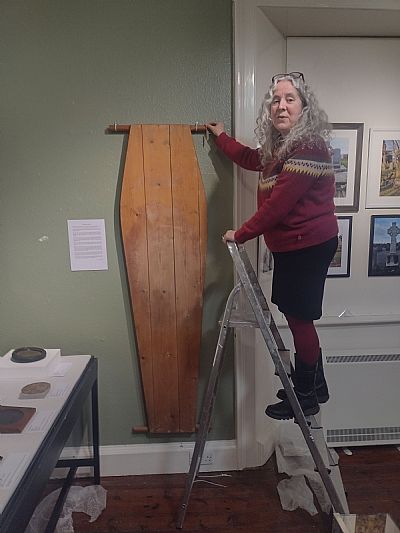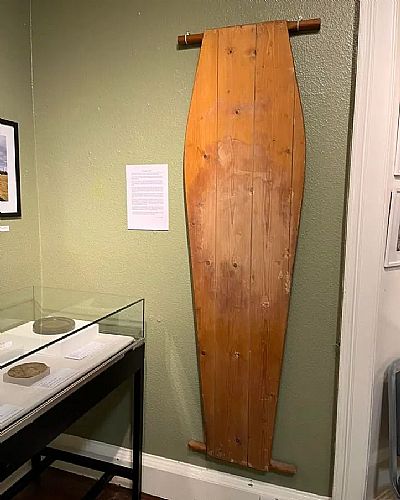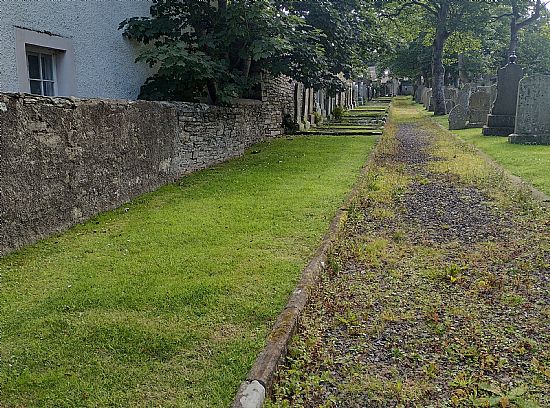*Orkney's Pauper's Coffin*
 There has been much interest in Orkney's Pauper's Coffin since the opening of the exhibition, with comments ranging from, 'who put the ironing board on the wall' to 'I think someone has lost their surfboard!' Because of this I thought it was only 'right and proper,' to give you some historical background, kindly provided here by Cathedral Curator Fran Flett Hollinrake (see left). This coffin-shaped wooden board was kept at the Orkney Combination Poorhouse and used for the burials of those who could not afford burial plots or headstones. In Medieval times, the poor of Orkney were looked after by churches and monasteries across the islands. The church authorities provided medical and social care services to those in need, and the assistance provided was often connected to Christian teachings.
There has been much interest in Orkney's Pauper's Coffin since the opening of the exhibition, with comments ranging from, 'who put the ironing board on the wall' to 'I think someone has lost their surfboard!' Because of this I thought it was only 'right and proper,' to give you some historical background, kindly provided here by Cathedral Curator Fran Flett Hollinrake (see left). This coffin-shaped wooden board was kept at the Orkney Combination Poorhouse and used for the burials of those who could not afford burial plots or headstones. In Medieval times, the poor of Orkney were looked after by churches and monasteries across the islands. The church authorities provided medical and social care services to those in need, and the assistance provided was often connected to Christian teachings.
In the late 1500s, following the Protestant Reformation in Scotland, responsibility for looking after the poor was passed from the churches to local parishes, who raised taxes for this purpose. The help provided could be very unreliable, and in the 1840s it was decided that there should be a reform of the way that poor people were looked after. The Poor Law (Scotland) Act 1845 saw the establishment of parochial boards throughout the country, governed by a central Board of Supervision in Edinburgh. Eventually small parish poorhouses, which had provided basic accommodation throughout the islands, were replaced by the Orkney Combination Poorhouse in Kirkwall.
Building started on the 50-bed Combination Poorhouse in 1882, and its opening in 1883 was reported by the Orkney Herald.
the Orkney Herald.
‘In the centre it is two stories high, containing committee room, office and governor’s and matron’s apartments, storerooms &c. The south portion of the front block is divided into small and large dormitories and day room for males, and the corresponding north portion for females, both having bathrooms, lavatories, and water-closets at the back, and also entrances to the airing yards…’
The Rules and Regulations for the Orkney Combination Poorhouse show that the ‘inmates’ were locked into their dormitories from 9pm until 6am. They were fed plain food, and much emphasis was put on the rooms being warm but well-ventilated. A barber visited once a week, and a Medical Officer made daily rounds. If one of the inmates died, their nearest relations were informed, and it was expected that they would take the person away for burial. If, however, ‘the body be not removed within a reasonable time,’ then the Poorhouse would ‘provide for the internment thereof’. In these cases, the deceased person would be wrapped in a shroud or a blanket and laid on the wooden board. Basic transportation would be provided to the area of the cathedral graveyard set aside for pauper burials, where a short service would be conducted by a minister at the graveside. The person would then be lowered into the grave and the hole backfilled. The wooden coffin board was then taken back to the Poorhouse for the next occasion.
In late 1800s, paupers’ coffins could be quite elaborate, with hinged panels to allow the person’s body to slide into the grave. This one is quite simple in design and was probably made by a local joiner or cabinet maker. Several local companies had contracts with the poorhouse, including JD Peace and Peter Leonard. The cathedral graveyard was no longer used for paupers’ burials after 1914. In 1930 the Combination Poorhouse became the County Home, and it is still used as sheltered housing, known as Andersquoy on Old Scapa Road.

Pauper's Burial Ground, St Magnus Cathedral Churchyard, Kirkwall
Fran Flett Hollinrake
